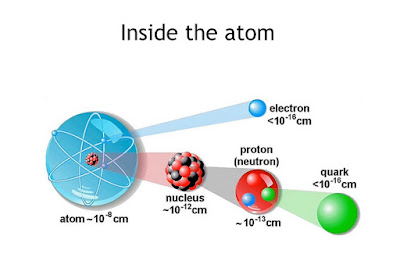My latest encounter with this beauty was during a lively discourse by David Tong, professor of theoretical physics at Cambridge University, titled "The real building blocks of the Universe." I drew most of the pictures from his talk.
David talked in the same lecture hall where Faraday, in 1828, demonstrated the phenomena of electricity on a piece of furniture still present today.
So here is the nowadays well-known illustration of the composition of matter …
The world is made up of 12 fundamental particles. Stable matter only needs the first row, where two up quarks and one down quark are held together by the strong nuclear force composing the proton; neutrons contain one up quark and two down quarks. Protons, neutrons, and electrons in various combinations form all
chemical elements.
Our world is held together by four known forces. These forces correspond to fields where "ripples" in those fields give rise to particles like gravitons, photons, quarks, and intermediate bosons,
The Higgs boson fills in a gap. Ripples in the Higgs field give particles
their mass.
So far, so good, or so far and not so good.
Physicists are not satisfied with the present Standard Model, as presented here in a so-called TOE:
In their time, Einstein and Heisenberg tried hard to develop a world formula. Einstein spent the last thirty years of his life formulating a
unified field theory, while in 1958, Heisenberg published his
Materiegleichung (matter equation). Without the present knowledge,
their efforts remained laudable patchwork.
As I mentioned before, the above equation does not allow for the calculation of the masses of particles and has no term for dark masses and energies. So, there must be more physics beyond the Standard Model. However, the search for "new" particles at energies available at the Large Hadron Collider (LHC) was
unsuccessful, but according to the New Physics, they are a must.
I read the following sentence in an article in Nature: Since the Standard Model was first put together in the 1970s, it has passed all tests and survived almost unchanged. But physicists are convinced that it must be incomplete, and some hope that muons will reveal its first failure.
The fact is that the magnetic moment g of the muon is slightly different from 2. In a first approximation, this difference is explained by the Standard Model and can be calculated within this model.
Because the g-factor of the muon may be affected by physics beyond the Standard Model, it has been measured very precisely in the past at CERN and recently independently at the Brookhaven National Laboratory and Fermilab near Chicago.
Red Baron still remembers the g-2 experiment at CERN beginning in the 1970s. At their muon storage ring, Emilio Picasso and his collaborators obtained a magnetic moment, i.e., a (g-2)/2 value for the muon of 0.001 162 ± 0.000 005, which Emilio and his team considered in agreement with the then theoretical value for the muon of 0.001 165.
I read the following sentence in an article in Nature: Since the Standard Model was first put together in the 1970s, it has passed all tests and survived almost unchanged. But physicists are convinced that it must be incomplete, and some hope that muons will reveal its first failure.
The fact is that the magnetic moment g of the muon is slightly different from 2. In a first approximation, this difference is explained by the Standard Model and can be calculated within this model.
Because the g-factor of the muon may be affected by physics beyond the Standard Model, it has been measured very precisely in the past at CERN and recently independently at the Brookhaven National Laboratory and Fermilab near Chicago.
Red Baron still remembers the g-2 experiment at CERN beginning in the 1970s. At their muon storage ring, Emilio Picasso and his collaborators obtained a magnetic moment, i.e., a (g-2)/2 value for the muon of 0.001 162 ± 0.000 005, which Emilio and his team considered in agreement with the then theoretical value for the muon of 0.001 165.
Progress in technology never stops. Look at the results. 2006, the discrepancy between the now accepted theoretical value of 0.001 165 918 1 and 0.001 165 920 9 for the (g-2)/2 value measured in the E821 experiment at Brookhaven smelled a new physics.
However, in the meantime, an independent measurement at Fermilab lowered the agreed experimental value to 0.001 165 920 6. At the same time, a recent "more refined "calculation by Szabolcs Borsanyi et al. resulted in a number for (g-2)/2 of 0.001 165 919 5.
Considering the uncertainties of both measurement (±0.000 000 000 6) and theoretical calculation (±0.000 000 000 9), do you still believe in physics beyond the Standard Model?
Or do you like the world on a string around your finger like
Ol' Blue Eyes? But that's another story; sorry, I mean theory.
*









No comments:
Post a Comment